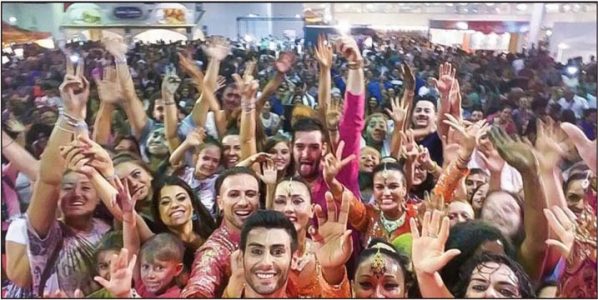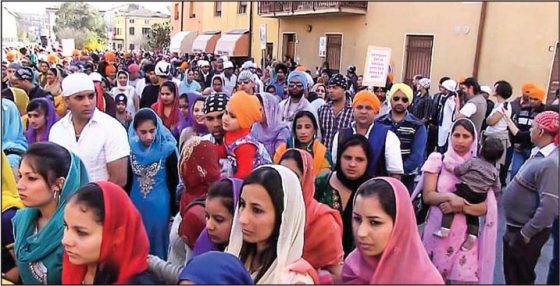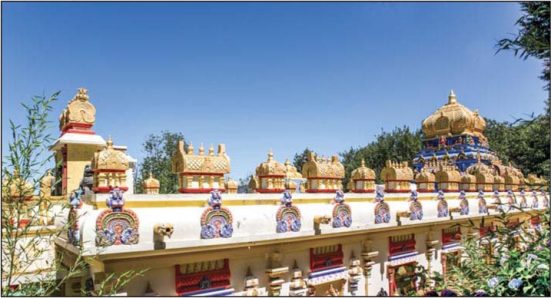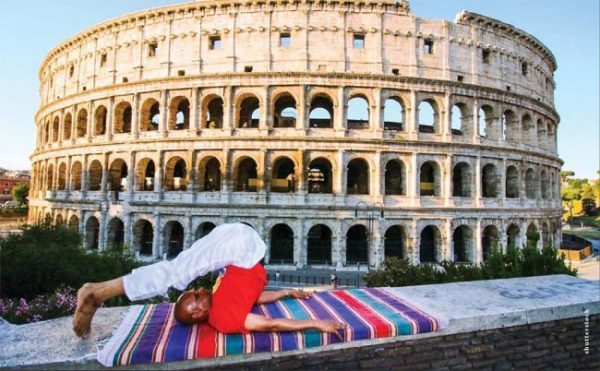Italy’s thriving Indian community and strong yoga scene demonstrate that the Sanatana Dharma is making inroads even into the bastion of Catholicism
BY LAVINA MELWANI
It was the most unlikely encounter. In the midst of a massive crowd of international tourists at Italy’s Leaning Tower of Pisa, I came across a thin, non-assuming Hindu gentleman from Chennai, smilingly selling home-made samosas and kachoris from a tote bag dangling from the handles of his bike! The samosas were flying and were gone by the time I met him—he just had a few kachoris left. His sold-out samosas were just one sign of how popular Indian food had become here. Heading to St. Peter’s Basilica at the Vatican, I encountered Hindu and Sikh vendors selling everything from statues of the pope to printed t-shirts. While I enjoyed dinner at a sidewalk café in Rome, a Sri Lankan man came around selling roses to make a living. When I bought a leather bag in a colorful market, the merchant was a Bangladeshi. In Venice I bought tiny earrings made of Murano glass, sold by a Hindu from India. The man who assisted me with road directions in Rome was a Pakistani who worked in an Italian restaurant. And in the public square sat a Hindu sadhu (or at least someone dressed in saffron robes) offering to take pictures with tourists for a few Euros or dollars!
People from the subcontinent are everywhere in Italy, working in agriculture, academic life, tourism, trade and as yoga teachers. I encountered Indians from Rome to Venice to Sienna. Italy’s desi universe is thriving—though far under the radar of most travelers. The Bureau of Labor’s statistics show there are well over 150,000 Indians in the country.
The small seaside town of Lavinia, in the Anzio region about 50 kilometers from Rome, has acquired a new name: ‘Love-India!’ This name is used informally even by the Italians because of the town’s large Indian population. With thousands of Indian migrants, the town has many Indian restaurants and Indian grocery stores. It is a place of temples, gurudwaras and prasad, bhangra and Bollywood.
I did not have an opportunity to visit the Hindu temples scattered across Italy, but the website of Unione Induista Italiana—the Italian Hindu Union—gives a great look at the varied temples and devout Hindu communities that exist in around the nation. There’s a national religious organization, the Sanatana Dharma Samgha, which represents all the Hindus living in Italy who recognize themselves in its values and ideals. Hinduism has been officially acknowledged by the Italian government as a religious denomination. Diwali, the festival of lights, is recognized in Italy as the official Hindu religious activity.
Italy’s temples include Mata Gitananda Ashram in Altare, Shree Nav Durga Mandir in Polesine Parmense (PR), Sanatan Dharm Mandir in Arzigano, Shri Hari Om Mandir in Pegognaga, Vaishno Mata Mandir in Novellara, Om Hindu Mandir in Rome, Durga Maa Mandir and Shiv Shakti Mandir (both in Catania) and many more; a virtual tour is available at bit.ly/HinduItaly.
Like any avid tourist, I visited many of the must-see spots of this beautiful country—the magic of Tuscany with its verdant vineyards, fig and olive trees and luxurious villas; the shimmering watery poetry of the magnificent floating city of Venice; the rich art treasures of Florence; and the fabulous ruins and intricate history of Rome.
But throughout my travels, as I enjoyed the cuisine and museums, I always kept my Indian-antennae up to spot South Asians in their new habitat and see what they were up to. Indians were everywhere, though not in large numbers—they were in the dough, in the ingredients and in the toppings of the Italian pizza! I met Indians from all walks of life—farmers, promoters of Italian culture and tourists visiting the country.
I visited the Indian Embassy in Rome and met with the then ambassador, Anil Wadhwa, seeking the official account of the Indians in Italy. “Italy is a country with whom India has had very deep commercial and economic ties,” he told me. “Our road map for the future is focused on the economic side—investments, cutting-edge science, technology and design. We also have traditional areas of cooperation in leather, textiles, gems and jewelry.”






India, Italian style: Ambli Abraham’s Bollymasala Dance Company celebrate the completion of their show before a packed Italian audience; street scene in Novaro in northwest Italy; Mata Gitananda Ashram in Altare
Migrant Tales
Rome alone has over 1,500 Indians, including dancers, academics and yoga teachers, and I spoke with several. Their individual stories help give the larger picture.
Sanjukta Das Gupta, who earlier taught at Calcutta University in India, moved to Italy when she married an Italian colleague. She now teaches at the Department of Oriental Studies at La Sapienza University of Rome, the first Indian historian to do so.
“The best part of Italy for me is that I live amid so much visible history,” she says. “Almost every road takes you to some site dating back to ancient times.” She speaks of Italy’s Indians in several groups: migrant laborers, mainly from Punjab and now working mostly in north and central Italy; restaurant workers, mainly Punjabi and Keralites; religious migrants, mostly Catholic priests and nuns, again mainly from Kerala; the “international set,” people working in the various UN organizations; students; and spouses, Indians married to Italians. These are mostly Indian women married to Italian men. Italian men often come back from India with a wife.
Statistics indicate most of Italy’s Indians are farmers from the Punjab, doing exactly what they did back home—farming—though many have added cheese-making to their skills. They are spread all over—in the north, around Rome, in the Lazio region, and also down south in Naples, Bari and Sicily. The rural areas are home to 80 percent of the Indian population. These dedicated agricultural workers have become a mainstay of Italy’s cheese industry. Punjabi films are played on Sundays in such areas.
Italy has taken in a large number of refugees, so the South Asian presence is quite noticeable. You can’t miss the Bangladeshis selling everything from tourist trinkets to roses on the sidewalks, and there are many Pakistani tour guides. Indians are also a big part of the tourism industry. Whether at the Trevi Fountain or the Vatican, you can’t miss the Indians, Bangladeshis and Pakistanis selling tours and souvenirs to the tourists.
Italy’s breathtaking natural beauty has made it a wedding destination, and big Indian weddings have been held at Florence, Milan, Rome and the Positano and Amalfi coasts. My extended family, 14 of us, came here for one such wedding, staying at a charming villa in Tuscany. Through the villa owner I met Balbir Singh Sangha, a Sikh chef. Sangha, who came from Hoshiarpur in the Punjab in 1989, started here as a farmer while learning the language. He went back home for an arranged marriage and now has children in their 20s. Gradually he got into cooking and for the past 20 years has worked in restaurants in Rome and Tuscany. He now cooks everything Italian—though food at home is always Indian food cooked by his wife. Were people in his village surprised when he first left for Italy? Singh laughed, “Everyone is leaving for abroad—now our Punjab is getting empty!”
Italy’s Hindus, though less numerous than the Sikhs, are also thriving. There are several temples in Italy and more under construction. Ambassador Wadhwa told me local governments have given land for temples, gurudwaras, and even cricket stadiums. In addition, the Indian government promotes Indian culture through festivals on the beaches in the tourism season. A Kathak dance performance by Shovana Narayan drew a crowd of 1,200 in the town square, renamed Wadhwa.
While visiting the Indian Embassy, I met Vishnu Kumar Soni, an exporter of scrap metal to India. Soni is one of the ardent devotees helping to build a Sanatan Dharma Mandir in Lavinio. There are already two temples in Rome and there has been a good response to the building of this new temple, he says. “Hindus from different parts of Italy come together in Lavinio for jagrans, Krishna Janmashtami, Navaratri and a week-long Diwali festival.”


The Italian-India scene: Serena and Rohan from London are married in a “destination” wedding in sunny Tuscon


The Italian-India scene: A Punjabi souvenir seller at the Vatican
Soni came many years ago as a tourist, liked it and decided to stay. He returned to India to get married, then brought his family to Italy. “Rome is a mini India,” he says. “The agricultural work is done mostly by Indians; almost 95 percent of Indians here are in agriculture. The young Italians are not into agriculture or construction, but our people are ready to do any kind of work, and are already comfortable in agricultural activities from India.” He points out that Lavinio—Love India—has a large enough South Asian population to support 16 Indian and 11 Pakistani grocery stores.
Bollywood filmmakers have discovered some of Italy’s breathtaking locations. Many Indian films have been shot in a place called Matera, famous because the houses are in rock caves in the hillsides and look ancient. Indian actor Kabir Bedi has acted on Italian television and has a strong following in the country. Italians enjoy Indian cinema. The “River to River” Indian film festival is in its 16th year in Venice. This is the passion of Selvaggia Velo, the festival’s founder. When I contacted her, she shared her motivation: “Indian films hardly get a release in Italy, and this festival is one of the only places where you get to see them. It all happened by chance—I liked India and cinema and decided to put the two things together. So with study and dedication, passion, intuition, and many other things, now we have just finished our 16th edition!”
Ambili Abraham, an Indian dancer whose father worked at the Indian Embassy in Rome, has built her career in Italy on the Bollywood craze. She started studying dance at the age of five and now runs a dance school in Rome. For the past 16 years she has held classes and workshops all over the country. Her Bollymasala Dance Company teaches her graduate students to become teachers themselves. Most of her students are Italians, but some are young Indians, adopted by Italian families, who are in search of their roots.
Abraham has often been on Italian TV and is reputedly the one who brought Bollywood dance to Italy. She says, “I have been blessed; my students give me lots of love and respect. Italy is now my second home. My main aim is to make my students love the Indian cinematic world and make Italians understand the power of Indian cinema.” She told me that another Bollywood dance school, the Bollywood Club, was recently opened in Rome by an Indian-Italian couple.
The Italian Yogis
Yoga and meditation are also big Indian influences in Italy. When the International Day of Yoga is celebrated worldwide, Italy’s participation is among the most enthusiastic.
Roshni Shekar, who came here from Kerala almost thirty years ago, now promotes yoga and meditation to Italians. She met and married her Italian husband in India, then they moved to Italy. Today they have two children—Maitreya Quircio, 23, and Flaminia Bhavani Quircio, 20.
A direct disciple of Swami Vishnu Devananda, one of Swami Sivananda’s most famous disciples, Shekar keeps the tenets of Hinduism vibrant. She recalls, “He was the one who started the International Sivananda Yoga Vedanta Centres, with more than 50 yoga missions worldwide. I did my teacher’s training courses at the Sivananda ashram, Neyyar Dam, Trivandrum, Kerala.” For 25 years she has taught yoga in Rome. She says, “Our center is named after my guru—Centro Yoga Swami Vishnu (cyswamivishnu.org). My students are mainly Italians, but there are a few other nationalities as well. I also teach at the United Nations World Food Program.”


The Italian-India scene: A Chennai native selling samosa at the Leaning Tower of Pisa
Her husband and children have also taken teachers training through the Sivananda program and have helped teach at her center.
“My guru’s mission was essentially to spread peace through yoga, so our center has done voluntary work in the high schools in Rome for the past eight years,” she says. “We take demonstrations, theory classes and practice classes to give a correct overall view of yoga to the young.” For the past three years, Shekar has also taught yoga, as a volunteer, to inmates at the Rebibbia women’s prison, where her classes are well received. Every year they also raise funds through various cultural activities to support animal organizations in India and help in the support and care of street animals.
Shekar explains hers is a raja yoga lineage—the classic, traditional yoga, emphasizing the study of metaphysical theory, the study of ancient philosophical texts, and a detailed study of physical yoga theory as well. One Saturday each month they offer a free class on Vedanta to all who want to attend. She told me, “We regularly hold two-day seminars and week-long retreats following the rigorous discipline of the ashrams in India. We also take a yoga vacation to Greece every June so people can practice yoga, study and have a sea vacation. I also visit other cities, when invited by yoga centers, to give lectures and conduct seminars.”
Shekar credits yoga with keeping her balanced in spite of having lived so many years outside of India. She says, “Being a yoga teacher, I am a deep believer in God and gurus. I firmly believe in the wider aspect of God, not in a limiting or limited way. I realize more and more that all that unites is yoga, and anything that separates is not yoga.
“Teaching in Italy was not easy when I started 25 years ago. Yoga was not well known then, and most students would come for physical benefits only. Now a lot of people come for spirituality. Italians are warm, loving people, very family oriented, very easy for Indians to connect with, as they share these qualities with Indians. Also, Italy is the mystic heart of the West, and the Italian land has that sacred power which India has.”
Little wonder then that the International Day of Yoga draws thousands of Italians to practice yoga on that day, including lots of schools. Yoga organizations partner together and hold gatherings in the central square as well as musical events in the evening.
Ayurveda, too, is gaining ground in Italy. In a recent Ayurveda conference in Milan, over 100 experts came from around the world to discuss this ancient science of well-being.
Tourism in both directions is thriving. “I think Italians feel a natural affinity towards Indians, and vice versa,” Ambassador Wadh wa told me. “Italians like the spirituality—like the Indian people—the food and the color. And Indians find Italian designs fascinating. The cities are beautiful; there is a lot of history and art here. Both countries are abundantly rich in art and history, so there’s a natural affinity.”
Both Italy and India have natural beauty, a rich and ancient culture and strong, family-minded people—an ideal foundation for a strong connection. The Hindus living in Italy are building temples, sharing community activities, working hard and becoming good Italians while maintaining—and spreading—their Indian culture.
Lavina Melwani is a New York based writer for several international publications. She blogs at Lassi with Lavina.
Follow @lavinamelwani


